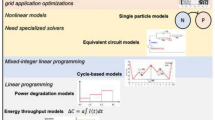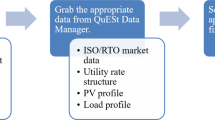Abstract
Purpose of Review
Energy storage is capable of providing a variety of services and solving a multitude of issues in today’s rapidly evolving electric power grid. This paper reviews recent research on modeling and optimization for optimally controlling and sizing grid-connected battery energy storage systems (BESSs). Open issues and promising research directions are discussed.
Recent Findings
Recent studies on BESS dispatch, evaluation, and sizing focus on advanced modeling and optimization methods to maximize stacked value streams from multiple services. BESS models have been improved to better represent operational characteristics or capture degradation effects. Different solution methods and optimization techniques have been proposed to improve the benefits and cost-effectiveness of BESSs, using deterministic approaches prevalently but with impressive progress in modeling and addressing uncertainties.
Summary
Recent progress in BESS scheduling and sizing better supports planning and operational decision-making in different use cases, which is highly important to advance the deployment of BESSs. Additional research is required to properly model the trade-off between short-term benefits and service life with multiple degradation effects explicitly considered in the decision-making process. Advanced methods are to be developed for effectively determining optimal BESS sizes that maximize overall benefits within a varying lifetime considering diversified system conditions, as well as uncertainties at planning and operational stages.
Similar content being viewed by others
References
Hesse HC, Schimpe M, Kucevic D, Jossen A. 2017. Lithium-ion battery storage for the grid—a review of stationary battery storage system design tailored for applications in modern power grids Energies 10(12). https://doi.org/10.3390/en10122107.
Balducci P, Alam J, Hardy T, Wu D. Assigning value to energy storage systems at multiple points in an electrical grid. Energy Environ Sci 2018;11(8):1926–1944. https://doi.org/10.1039/C8EE00569A.
Koohi-Fayegh S, Rosen M. A review of energy storage types, applications and recent developments. J Energy Storage 2020;27:101047. https://doi.org/10.1016/j.est.2019.101047.
U.S. Department of Energy: DOE OE global energy storage database. https://www.sandia.gov/ess-ssl/global-energy-storage-database-home/.
Twitchell J. A review of state-level policies on electrical energy storage. Current Sustain/Renew Energy Rep 2019;6(2):35–41. https://doi.org/10.1007/s40518-019-00128-1.
U.S. Energy Information Administration: Battery storage in the United States: an update on market trends, July 2020. https://www.eia.gov/analysis/studies/electricity/batterystorage/pdf/battery_storage.pdf.
Ratnam EL, Weller SR, Kellett CM. An optimization-based approach to scheduling residential battery storage with solar PV: assessing customer benefit. Renew Energy 2015;75:123–134. https://doi.org/10.1016/j.renene.2014.09.008.
Wogrin S, Gayme DF. Optimizing storage siting, sizing, and technology portfolios in transmission-constrained networks. IEEE Trans Power Syst 2015;30(6):3304–3313. https://doi.org/10.1109/TPWRS.2014.2379931.
Wu D, Jin C, Balducci P, Kintner-Meyer M. An energy storage assessment: using optimal control strategies to capture multiple services. Proceedings of the IEEE Power and Energy Society General Meeting. Denver; 2015. p. 1–5. https://doi.org/10.1109/PESGM.2015.7285820.
Atia R, Yamada N. Sizing and analysis of renewable energy and battery systems in residential microgrids. IEEE Trans Smart Grid 2016;7(3):1204–1213. https://doi.org/10.1109/TSG.2016.2519541.
Byrne RH, Concepcion RJ, Silva-Monroy CA. Estimating potential revenue from electrical energy storage in PJM. Proceedings of the IEEE Power and Energy Society General Meeting; 2016. p. 1–5. https://doi.org/10.1109/PESGM.2016.7741915.
Fang H, Wu D, Yang T. Cooperative management of a lithium-ion battery energy storage network: a distributed MPC approach. Proceedings of the IEEE Conference on Decision and Control. Las Vegas; 2016. p. 4226–4232. https://doi.org/10.1109/CDC.2016.7798911.
Fang X, Li F, Wei Y, Cui H. Strategic scheduling of energy storage for load serving entities in locational marginal pricing market. IET Gener Trans Distrib 2016;10(5):1258–1267. https://doi.org/10.1049/iet-gtd.2015.0144.
Fernandez-Blanco R, Dvorkin Y, Xu B, Wang Y, Kirschen DS. Optimal energy storage siting and sizing: a WECC case study. IEEE Trans Sustain Energy 2016;PP(99):1–1. https://doi.org/10.1109/TSTE.2016.2616444.
Sharma S, Bhattacharjee S, Bhattacharya A. Grey wolf optimisation for optimal sizing of battery energy storage device to minimise operation cost of microgrid. IET Gener Trans Distrib 2016;10(3):625–637. https://doi.org/10.1049/iet-gtd.2015.0429.
Wu D, Kintner-Meyer M, Yang T, Balducci P. Economic analysis and optimal sizing for behind-the-meter battery storage. Proceedings of the IEEE Power and Energy Society General Meeting. Boston; 2016. p. 1–5. https://doi.org/10.1109/PESGM.2016.7741210.
Kazemi M, Zareipour H, Amjady N, Rosehart Wd, ehsan M. Operation scheduling of battery storage systems in joint energy and ancillary services markets. IEEE Trans Sustain Energy 2017;8(4): 1726–1735. https://doi.org/10.1109/TSTE.2017.2706563.
Marley JF, Molzahn D.k, hiskens IA. Solving multiperiod OPF problems using an AC-QP algorithm initialized with an SOCP relaxation. IEEE Trans Power Syst 2017;32(5):3538–3548. https://doi.org/10.1109/TPWRS.2016.2636132.
Wu D, Yang T, Stoorvogel AA, Stoustrup J. Distributed optimal coordination for distributed energy resources in power systems. IEEE Trans Autom Sci Eng 2017;14(2):414–424. https://doi.org/10.1109/TASE.2016.2627006.
Wu D, Kintner-Meyer M, Yang T, Balducci P. Analytical sizing methods for behind-the-meter battery storage. J Energy Storage 2017;12:297–304. https://doi.org/10.1016/j.est.2017.04.009.
Cherukuri A, Cortés J. Distributed coordination of DERs, with storage for dynamic economic dispatch. IEEE Trans Autom Control 2018;63(3):835–842. https://doi.org/10.1109/TAC.2017.2731809.
Fang X, Hodge B, Bai L, Cui H, Li F. Mean-variance optimization-based energy storage scheduling considering day-ahead and real-time LMP, uncertainties. IEEE Trans Power Syst 2018;33(6):7292–7295. https://doi.org/10.1109/TPWRS.2018.2852951.
Hao H, Wu D, Lian J, Yang T. Optimal coordination of building loads and energy storage for power grid and end user services. IEEE Trans Smart Grid 2018;9(5):4335–4345. https://doi.org/10.1109/TSG.2017.2655083.
Namor E, Sossan F, Cherkaoui R, Paolone M. Control of battery storage systems for the simultaneous provision of multiple services. IEEE Trans Smart Grid 2019;10(3):2799–2808. https://doi.org/10.1109/TSG.2018.2810781.
Sedighizadeh M, Esmaili M, Jamshidi A, Ghaderi MH. Stochastic multi-objective economic-environmental energy and reserve scheduling of microgrids considering battery energy storage system. Int J Electr Power Energy Syst 2019;106:1–16. https://doi.org/10.1016/j.ijepes.2018.09.037.
Shuai H, Fang J, Ai X, Tang Y, Wen J, he H. Stochastic optimization of economic dispatch for microgrid based on approximate dynamic programming. IEEE Trans Smart Grid 2019;10(3):2440–2452. https://doi.org/10.1109/TSG.2018.2798039.
Balducci P, Mongird K, Wu D, Wang D, Fotedar V, Dahowski RT. An evaluation of the economic and resilience benefits of a microgrid in Northampton, Massachusetts. Energies. 2020;13. https://doi.org/10.3390/en13184802. 4802.
Das A, Ni Z, Zhong X, Wu D. Experimental validation of approximate dynamic programming based optimization and convergence on microgrid applications. In: Proceedings of the IEEE Power and Energy Society General Meeting; 2020.
Wu D, Ma X, Huang S, Fu T, Balducci P. Stochastic optimal sizing of distributed energy resources for a cost-effective and resilient microgrid. Energy. 2020;198. . 117284.
Zhu J, Chen L, Wang X, Yu L. Bi-level optimal sizing and energy management of hybrid electric propulsion systems. Appl Energy 2020;114134:260. https://doi.org/10.1016/j.apenergy.2019.114134.
Hu W, Wang P, Gooi HB. 2016. Assessing the economics of customer-sited multi-use energy storage. In: IEEE Region 10 conference (TENCON), pp 651–654. https://doi.org/10.1109/TENCON.2016.7848083.
Ju C, Wang P. 2016. Energy management system for microgrids including batteries with degradation costs. In: IEEE International conference on power system technology (POWERCON), pp 1–6. https://doi.org/10.1109/POWERCON.2016.7754011.
Liu Y, Du W, Xiao L, Wang H, Bu S, Cao J. Sizing a hybrid energy storage system for maintaining power balance of an isolated system with high penetration of wind generation. IEEE Trans Power Syst 2016;31(4):3267–3275. https://doi.org/10.1109/TPWRS.2015.2482983.
Bordin C, Anuta HO, Crossland A, Gutierrez IL, Dent CJ, Vigo D. A linear programming approach for battery degradation analysis and optimization in offgrid power systems with solar energy integration. Renew Energy 2017;101:417–430. https://doi.org/10.1016/j.renene.2016.08.066.
Abdulla K, De hoog J, Muenzel V, Suits F, Steer K, Wirth A, Halgamuge S. Optimal operation of energy storage systems considering forecasts and battery degradation. IEEE Trans Smart Grid 2018;9(3):2086–2096. https://doi.org/10.1109/TSG.2016.2606490.
Akhavan-Hejazi H, Mohsenian-Rad H. Energy storage planning in active distribution grids: A chance-constrained optimization with non-parametric probability functions. IEEE Trans Smart Grid 2018;9(3):1972–1985. https://doi.org/10.1109/TSG.2016.2604286.
Cheng B, Powell WB. Co-optimizing battery storage for the frequency regulation and energy arbitrage using multi-scale dynamic programming. IEEE Trans Smart Grid 2018;9(3):1997–2005. https://doi.org/10.1109/TSG.2016.2605141.
Correa-Florez CA, Michiorri A, Kariniotakis G. Robust optimization for day-ahead market participation of smart-home aggregators. Appl Energy 2018;229:433–445. https://doi.org/10.1016/j.apenergy.2018.07.120.
Foggo B, Yu N. Improved battery storage valuation through degradation reduction. IEEE Trans Smart Grid 2018;9(6):5721–5732. https://doi.org/10.1109/TSG.2017.2695196.
Xu Y, Zhao T, Zhao S, Zhang J, Wang Y. Multi-objective chance-constrained optimal day-ahead scheduling considering BESS degradation. CSEE J Power Energy Syst 2018;4(3):316–325. https://doi.org/10.17775/CSEEJPES.2016.01050.
Zhou J, Tsianikas S, Birnie DP, Coit DW. Economic and resilience benefit analysis of incorporating battery storage to photovoltaic array generation. Renew Energy 2019;135:652–662. https://doi.org/10.1016/j.renene.2018.12.013.
Bahloul M, Khadem SK. An analytical approach for techno-economic evaluation of hybrid energy storage system for grid services. J Energy Storage 2020;101662:31. https://doi.org/10.1016/j.est.2020.101662.
Shang Y, Wu W, Guo J, Ma Z, Sheng W, Lv Z, Fu C. Stochastic dispatch of energy storage in microgrids: An augmented reinforcement learning approach. Appl Energy. 2020;261). 114423.
Hamedi A, Rajabi-Ghahnavieh A. Explicit degradation modelling in optimal lead–acid battery use for photovoltaic systems. IET Gener Trans Distrib 2016;10(4):1098–1106. https://doi.org/10.1049/iet-gtd.2015.0163.
Alharbi H, Bhattacharya K. Stochastic optimal planning of battery energy storage systems for isolated microgrids. IEEE Trans Sustain Energy 2017;9(1):211–227. https://doi.org/10.1109/TSTE.2017.2724514.
Braeuer F, Rominger J, McKenna R, Fichtner W. Battery storage systems: an economic model-based analysis of parallel revenue streams and general implications for industry. Appl Energy 2019;239:1424–440. https://doi.org/10.1016/j.apenergy.2019.01.050.
Kim SK, Kim JY, Cho KH, Byeon G. Optimal operation control for multiple BESSs, of a large-scale customer under time-based pricing. IEEE Trans Power Syst 2017;33(1):803–816. https://doi.org/10.1109/TPWRS.2017.2696571.
Copp DA, Nguyen TA, Byrne RH. Adaptive model predictive control for real-time dispatch of energy storage systems. Proceedings of the IEEE American Control Conference. IEEE; 2019. p. 3611–3616. https://doi.org/10.23919/ACC.2019.8814902.
Nguyen TA, Copp DA, Byrne RH, Chalamala BR. Market evaluation of energy storage systems incorporating technology-specific nonlinear models. IEEE Trans Power Syst 2019;34(5):3706–3715. https://doi.org/10.1109/TPWRS.2019.2909764.
Wu D, Balducci P, Crawford A, Mongird K, Ma X. Building battery energy storage system performance data into an economic assessment. Proceedings of the IEEE Power and Energy Society General Meeting; 2020.
Cao J, Harrold D, Fan Z, Morstyn T, Healey D, li K. Deep reinforcement learning-based energy storage arbitrage with accurate lithium-ion battery degradation model. IEEE Trans Smart Grid 2020;11 (5):4513–4521. https://doi.org/10.1109/TSG.2020.2986333.
Fortenbacher P, Mathieu JL, Andersson G. Modeling, identification, and optimal control of batteries for power system applications. Proceedings of the IEEE Power Systems Computation Conference. IEEE; 2014. p. 1–7. https://doi.org/10.1109/PSCC.2014.7038360.
Li Z, Guo Q, Sun H, Wang J. Extended sufficient conditions for exact relaxation of the complementarity constraints in storage-concerned economic dispatch. CSEE J Power Energy Syst 2018; 4(4):504–512. https://doi.org/10.17775/CSEEJPES.2016.01120.
Nasrolahpour E, Kazempour SJ, Zareipour H, rosehart WD. Strategic sizing of energy storage facilities in electricity markets. IEEE Trans Sustain Energy 2016;7(4):1462–1472. https://doi.org/10.1109/TSTE.2016.2555289.
Wankmüller F, Thimmapuram PR, Gallagher KG, Botterud A. Impact of battery degradation on energy arbitrage revenue of grid-level energy storage. J Energy Storage 2017;10:56–66. https://doi.org/10.1016/j.est.2016.12.004.
Stroe D, Knap V, Swierczynski M, Stroe A, teodorescu R. Operation of a grid-connected lithium-ion battery energy storage system for primary frequency regulation: a battery lifetime perspective. IEEE Trans Industry Appl 2017;53(1):430–438. https://doi.org/10.1109/TIA.2016.2616319.
Powell WB, Meisel S. Tutorial on stochastic optimization in energy–Part I, Modeling and policies. IEEE Trans Power Syst 2016;31(2):1459–1467. https://doi.org/10.1109/TPWRS.2015.2424974.
Funding
We are grateful to Imre Gyuk, who is the Director of Energy Storage Research in the Office of Electricity at the U.S. Department of Energy, for providing financial support and leadership on this and other related work at Pacific Northwest National Laboratory.
Author information
Authors and Affiliations
Corresponding author
Ethics declarations
Conflict of Interest
The authors declare no competing interests.
Additional information
Human and Animal Rights and Informed Consent
This article does not contain any studies with human or animal subjects performed by any of the authors.
Publisher’s Note
Springer Nature remains neutral with regard to jurisdictional claims in published maps and institutional affiliations.
This article belongs to the Topical Collection: Topical Collection on Energy Storage
This material is based upon work supported by the U.S. Department of Energy (DOE), Office of Electricity through the Energy Storage program. Pacific Northwest National Laboratory is operated for the DOE by Battelle Memorial Institute under Contract DE-AC05-76RL01830.
Rights and permissions
About this article
Cite this article
Wu, D., Ma, X. Modeling and Optimization Methods for Controlling and Sizing Grid-Connected Energy Storage: A Review. Curr Sustainable Renewable Energy Rep 8, 123–130 (2021). https://doi.org/10.1007/s40518-021-00181-9
Accepted:
Published:
Issue Date:
DOI: https://doi.org/10.1007/s40518-021-00181-9




